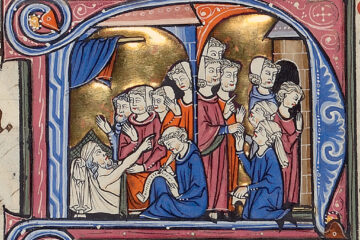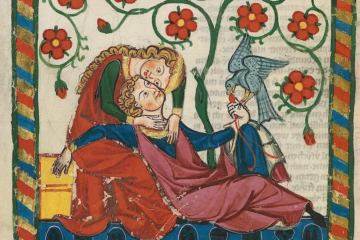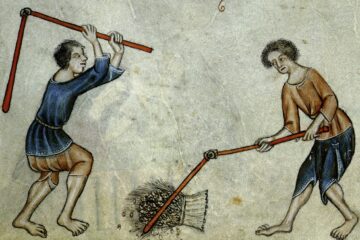by Bradford Livingston
During ancient times, the sciences and arts blossomed, having put man in their forefront. However, this changed with the dissolution of Western Rome, which marked the beginning of the Dark Ages, where the church held absolute authority over every aspect of life.
However, Emperor Alfred “the Great” during his reign decreed that “The Church, although an essential part of society, will not meddle in affairs which do not concern it.” After this, the “Humanism act” was passed which gave men of knowledge and art the freedom they needed to pursue their callings. The sciences and art flourished under the protection of this act, bringing advancements in every type of technology and bringing amazing works of art to the world.
Still, some parts of the world did not agree with what the Emperor meant, claiming God had sovereignty over all. The only prominent heretic Church which follows this principle is the “Church of England”, which gained support by claiming that the nobility was trying to subdue the clergy and the people.
Marcus Freeman
Theater master and philosopher Markus Freeman rested his chin against his knuckles and gazed across a room of empty chairs. After months of moments like these, Freeman was again thinking of the musical Godspell and his hopes for the coming production.
“From the show, in it of itself, I want the audience to learn more about God,” said Freeman, his voice echoing through the space of the conference room. “I want them to learn about how talented our community is. I want them to know that musical theater can be engaging and can speak to all sorts of different people.”
Though this musical is an example of one that may not be considered controversial, many paintings, novels, plays, and other forms of art have the potential to be immoral and contain topics that challenge the opinions of many Christians.
But, in the world today, what actually is considered art and why can it be so controversial?
“My definition of good art is: did it evoke an emotional response in you?”
Marcus Freeman
In his eyes, even if viewing a play or seeing a painting evokes negative feelings in the viewer, the emotional response itself is what makes it good art.
Aside from causing an emotional reaction, good art can also express opinions, document stories, raise questions, and invoke discussion. It takes the form of music, plays, novels, paintings, dancing, writing. No matter which of its forms, art plays a large role in society.
Davin Hogins
I’ve had a couple of questions come my way lately asking me about my faith and my paintings. Usually, it’s a short question: “does your faith, or God, affect your art?” I preach often, but usually about gear and vision and the trappings of our craft. When I do speak on matters of faith it is not often about my own, so I trust you’ll read the rest of this without worrying that I’m about to step off into the deep end of propaganda.
Fact is, faith is a profound part of the human experience, and while we have an unusual taboo about discussing such things in Europe, I’m never quite sure why. I mean, other than the fact that it draws such strong feelings from us that we’re ready to kill and plunder over the matter, even when what we feel so strongly about seems to include fairly unambiguous commands to love and not kill. Given how profoundly important our beliefs are – theistic or otherwise – I’m surprised we don’t discuss the connection between faith and art more openly. I mean, if it does stir such strong feelings, isn’t this a source we ought to explore, or at very least inform our art? Poets for centuries, and most particularly the bad ones, have allowed their love and lust to inform their poetry, so why not allow faith, or more broadly, allow your beliefs in general, to consciously inform art?
I was chatting with my friend Jeffrey Chapman, debating the issue of art vs. craft. He said something that caught me as profound. Art must have something of the artist within. It’s an act of expression, of self-revelation, and as such what is on the inside comes out on the outside. Honest art – and all art is honest or it’s propaganda or kitsch – reveals something of the artist, whether others see it or not. To return to what Jeffrey was saying, not everyone likes or understands Homer’s work, but that doesn’t make it any less an act of revelation or expression.
And so of course, faith comes into play. It must. It’s so inextricably part of our deepest being it should inform what we capture, how we capture it, and why. We might not be aware of it. It might not seem overly spiritual, but what we create comes from the things we believe about life, ourselves, others, and God’s presence – or absence. What is the history of European art without the crucifixion, a symbol of both God’s presence and His absence?
So what? Well for people who identify themselves as people of faith, and those who do not, it’s an appeal to tend to your deepest places. We create from the inside out, and how you perceive the world, what you want to show to the rest of us, and how you want to do that, is connected to the inside. Neglecting the inner life in favor of memorizing the
Bible is bound to lead to work that is less inspired than the work you create when you are engaged in life and filling the creative, spiritual, and emotional well constantly.
For me, my deeply held faith shapes who I am, and is the prime mover in my life. It’s why I work with the people I do and tell the stories I tell. It’s why I advocate for respect and kindness, why I feel stories about the poor and excluded not only can be told but must be told. It’s why much of my work centers around the two primal hungers of man – hunger of the body and hunger of spirit. I like to think that the light of this comes through in my paintings, that because I believe, like St. Paul wrote: now abideth these three things, faith, hope, and love, but the greatest of these is love, my work looks toward hope and is created, I trust, be the effect of all three.
If art is to have something of the artist within, then the things we think and believe are not trifling details, they are the starting place for any act of expression.
Gregory Faymillian
I was born a man, and therefore I have had human desires. But instead of pursuing those, I chose to free myself from sin and work towards a better life on Earth and in Heaven.
Ever since I was a boy of 16, I have lived in the Church a few miles from Alparis. There, Father Michel taught me the inner working of life and the World around us.
The horrible truth is, some people are stupid and therefore afraid of God. With artists freely sharing their works and with scientists disproving long-known facts about our surroundings they may stray from the path which God had intended for them to follow. Art in its purest form is uncensored and, by being so, sinful. A painting depicting a naked woman may give Holy men urges to forsake their vows. Town’s music serves only as a distraction to those who could instead be involving themselves with Faith.


